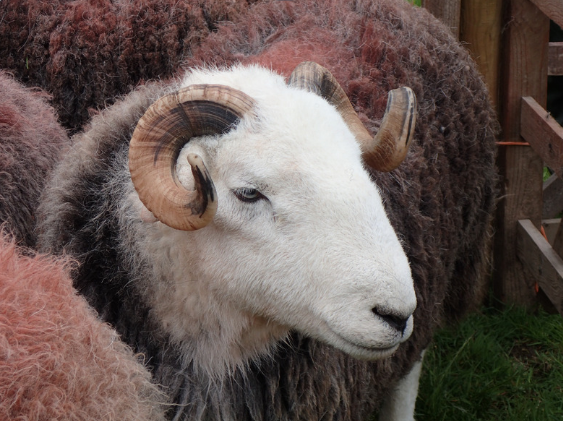WOOLS OF THE UK: Herdwick

The face of the Lake District! The hardy Herdwick is a breed that is easily recognisable, even if you aren’t a wool-lover. Who can resist that softly smiling face? It is easy to tell the ewes and rams apart as the rams have curled horns and the ewes are polled (hornless).
Colour
Varying shades of grey. Younger sheep tend to be darker, steel grey in colour with older sheep fading to a stately paler grey as they age.
Staple Length
85 – 90mm
Micron Count
35 – 40mic
Country of Origin
United Kingdom, specifically the Lake District.
History
The Herdwick has been found in the Lake District since the 1300s, though its origins before this have been attributed to both the Vikings and the Spanish Armada! Research has shown them to be of the same genetic type as a European Short-tailed sheep that could have arrived in the UK over 5,000 years ago.
They are extremely hardy and self-sufficient, being able to survive quite happily on the forage found on the fells without the need for additional food. This is where the nickname ‘Gardeners of the Lake District’ has come from as they graze on such a variety of plants that it helps to keep everything under control.
With so many flocks across the Fells it was decided that a breed standard was needed to ensure that the quality and standard of the breed was maintained. This in turn would make sure that the sheep grazing the Fells maintained the characteristics to survive in the high, harsh environment and continue to be a productive resource for the farms. The Herdwick Breed Society was founded in 1899 and then the Flock Book Society was founded in 1916.
Of course, you can’t think of the Herdwick without thinking of Beatrix Potter who took a shine to this breed and can be credited with helping boost its popularity. Her Lake District farms kept flocks, here she employed expert local shepherds and worked with them to constantly improve the health and quality of the breed. When she passed away the National Trust were left her farms on the understanding that the Herdwick flocks were to remain, which they did. These farms still continue to graze Herdwick flocks.
Wool prices have dropped dramatically since the times of Beatrix Potter and a coarse wool such as Herdwick has been affected by this. Over the past few years small businesses have worked tirelessly to create products from these fleeces and reintroduce value to the Herdwick’s characterful wool. As a direct result of this there is now a growing market; blankets, bags and homewares are all available in Herdwick wool as well as yarns.
Uses
Originally Herdwicks were bred as a dual-purpose breed for meat and wool. However, with the advent of softer, man-made fibres the popularity of their wool began to decline. Luckily it has seen a revival in recent years with it being used in many woven products due to its heard wearing and long-lasting nature.
Did you know… The name ‘Herdwyk’ is Old Norse for ‘sheep pasture’ – so many be they are Viking sheep!
You can find Herdwick in top form here.





